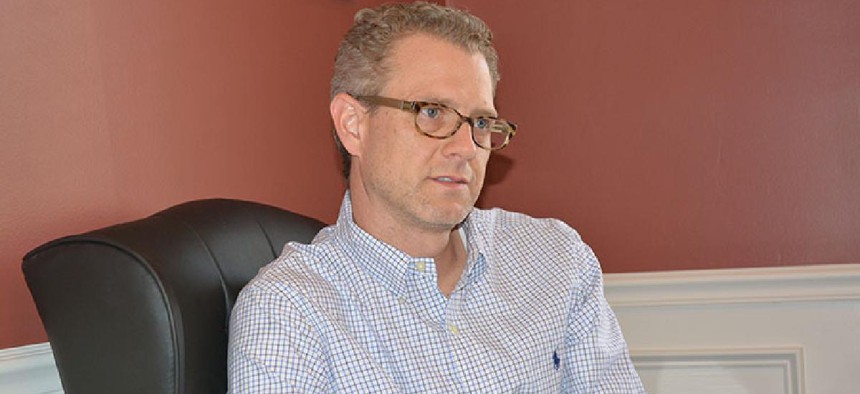Elections (Archived)
A Q&A with polling guru Brock McCleary

“The consent of the governed.” These five pivotal words in the Declaration of Independence contain the very core of how American government functions. They also provide the raison d’etre for those who make a living out of determining just what those being governed are willing to consent to: pollsters like Brock McCleary of Harrisburg-based Harper Polling.
McCleary, a Pennsylvania native, started his company in the wake of the 2012 election – he was the polling director of the National Republican Congressional Committee – leaving Washington, D.C., for the state capital. He has positioned Harper Polling to be the Republican version of Public Policy Polling, right down to its extensive use of the Interactive Voice Response automated survey technique, which has allowed him to reach many more households at a fraction of the cost of traditional live polling.
The move has a certain symmetry to it. In addition to Pennsylvania being McCleary’s home state, the first recorded instance of a public poll in the United States – a straw poll between Andrew Jackson and John Quincy Adams during the 1824 presidential race – was conducted by the Harrisburg Pennsylvaniannewspaper.
McCleary took some time off from crunching data to talk about what drew him to the polling profession, where it’s headed, and what and who he’ll be watching in the state’s primary on April 26.
C&S: When and how did you first get interested in politics?
BM: I was about 12 years old; it was 1988, and Dick Gephardt was running for president. We had Gephardt volunteers working out of our house. I guess I was enlisted in the campaign – I got interested, attended some political events and caught the bug. The Kennedys became a fascination thereafter – Democratic politicians got me interested at the outset. People will tell you partisanship is not one of my best traits.
C&S: Why focus on polling?
BM: This was what I wanted to do; I’ve spent a lifetime building experience, and this was how I wanted to apply it. I’m fascinated by the ability of polling to make the unexplainable logical in politics. I’m less interested in outcomes than I am in why things happen. The ability to take the data and communicate it in a way that works with the flow of the campaign – a lot of the people who are in politics but don’t have a lot of experience with polling don’t understand the way the data fits the context and the flow of the campaign. The ability to interpret that in a real-world way – there is no higher skill than the ability to communicate what you find.
C&S: Could you elaborate on some of the changes the industry has gone through in recent years?
BM: It’s getting harder for many folks out there – the cost of polling is going up. Everyone is dealing with the declining connectivity on landlines and looking to bring in more sampling from mobile phones, doing a lot of online polling. If you look to the future – 10, 20 years from now – we’re going to be collecting data from several different methods, commonly referred to now as mixed mode – some of your landline samples from automated phones, some cell phone responses from live callers, some email responses to collect responses online.
C&S: What is one misconception about polling you wish you could clear up for people?
BM: Probably that it is rare that the number you see on the topline poll is the exact number – there is a margin of error built into every poll. I say that reluctantly, because we have a pretty good history in the last four years of getting polls correct right to the number. For people who are really using polling, and making important spending decisions, whether in marketing or campaigns, it is really about understanding the data. You can have a topline number where you’re in the lead by 5 points, but I can look at the crosstabs and tell that your goose is cooked because fundamentally, the right demographics are not there for you to win that race.
C&S: Which races are you watching in the Pennsylvania primary?
BM: There are none bigger than the race here for the Senate. There is not a tremendous chance the Republicans can hold the majority in the U.S. Senate without winning in Pennsylvania. In 2010, Toomey won by 2 points while Republicans were gaining 63 seats in the House and Tom Corbett was winning by 10 percent, so to me, everyone has understood he has a really tough challenge. The interesting thing is the primary – no one can quite figure out who would be the best Democrat to win. The maverick image they have created for Sestak – were he to win the primary, he would only be emboldened and strengthened for the general election.
C&S: What intrigues you about the presidential campaign?
BM: It’s unclear who will prevail at the convention for the Republicans. Despite the untold story of how well Sanders is doing here and just how much of the Democratic electorate is soundly rejecting Clinton, she is likely to be the nominee. What I see in the data is that a Trump-Clinton matchup has the potential to truly realign the coalitions in the electorate and frankly, I think that is to the benefit of American politics. I’m not rooting for outcomes in any way, but I am interested in seeing a little bit of realignment in American politics – and Trump-Clinton would really have the chance to do that. It has the potential to be a “TMZ” election in a world that has only been used to the “Today Show.” And it is a chance to get a lot of people out to the polls – participation is good.
NEXT STORY: What has Jim Kenney accomplished?
